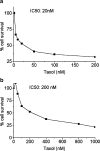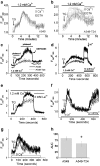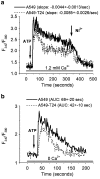Differential regulation of calcium homeostasis in adenocarcinoma cell line A549 and its Taxol-resistant subclone
- PMID: 15066902
- PMCID: PMC1574945
- DOI: 10.1038/sj.bjp.0705755
Differential regulation of calcium homeostasis in adenocarcinoma cell line A549 and its Taxol-resistant subclone
Abstract
Drug resistance is a fundamental problem in cancer chemotherapy. Intracellular calcium concentration ([Ca2+](i)) may play a role in the development of chemoresistance. We investigated the regulatory role of [Ca2+](i) in Taxol resistance in the non-small-cell lung cancer cell line A549 and its chemoresistant subclone A549-T24. Measurement of cytosolic calcium ([Ca2+](c)) in single cells and cell populations revealed similar levels of basal calcium in the two cell lines. However, a reduced response to thapsigargin (a sarcoplasmic/endoplasmic reticulum Ca2+-ATPase (SERCA) inhibitor) in A549-T24 cells compared to the parent cell line suggested a lower ER Ca2+ content in these cells. mRNA expression of SERCA2b and SERCA3, major Ca2+ pumps involved in ER Ca2+ homeostasis, did not significantly differ between the two cell lines, as revealed by RT-PCR. An altered calcium influx pathway in the Taxol-resistant cell line was observed. Modulation of the ER calcium pools using CMC (4-chloro-m-cresol) and ATP revealed lower ryanodine receptor (RyR) and IP(3) receptor (IP(3)R)-sensitive Ca2+ stores in the chemoresistant cell line. Western blot and RT-PCR studies suggested that A549-T24 cells expressed higher levels of the antiapoptotic protein Bcl-2 and the calcium-binding protein sorcin, respectively, in comparison to the parent cell line. Both of these proteins have been previously implicated in chemoresistance, in part, due to their ability to modulate[Ca2+](i). These results suggest that altered intracellular calcium homeostasis may contribute to the Taxol-resistant phenotype.
Figures











Similar articles
-
2-Aminoethoxydiphenyl borate perturbs hormone-sensitive calcium stores and blocks store-operated calcium influx pathways independent of cytoskeletal disruption in human A549 lung cancer cells.Biochem Pharmacol. 2005 Apr 15;69(8):1177-86. doi: 10.1016/j.bcp.2005.01.011. Biochem Pharmacol. 2005. PMID: 15794938
-
The hedgehog pathway inhibitor GDC-0449 alters intracellular Ca2+ homeostasis and inhibits cell growth in cisplatin-resistant lung cancer cells.Anticancer Res. 2012 Jan;32(1):89-94. Anticancer Res. 2012. PMID: 22213292
-
Overexpression of P-glycoprotein in L1210/VCR cells is associated with changes in several endoplasmic reticulum proteins that may be partially responsible for the lack of thapsigargin sensitivity.Gen Physiol Biophys. 2008 Sep;27(3):211-21. Gen Physiol Biophys. 2008. PMID: 18981537
-
Role of calcium in toxic and programmed cell death.Adv Exp Med Biol. 1991;283:419-25. doi: 10.1007/978-1-4684-5877-0_57. Adv Exp Med Biol. 1991. PMID: 1648868 Review.
-
The role of Ca2+ in cell killing.Chem Res Toxicol. 1990 Nov-Dec;3(6):484-94. doi: 10.1021/tx00018a001. Chem Res Toxicol. 1990. PMID: 2103319 Review. No abstract available.
Cited by
-
Sorcin regulate pyroptosis by interacting with NLRP3 inflammasomes to facilitate the progression of hepatocellular carcinoma.Cell Death Dis. 2023 Oct 13;14(10):678. doi: 10.1038/s41419-023-06096-1. Cell Death Dis. 2023. PMID: 37833249 Free PMC article.
-
Sorcin links calcium signaling to vesicle trafficking, regulates Polo-like kinase 1 and is necessary for mitosis.PLoS One. 2014 Jan 10;9(1):e85438. doi: 10.1371/journal.pone.0085438. eCollection 2014. PLoS One. 2014. PMID: 24427308 Free PMC article.
-
CACNA1B (Cav2.2) Overexpression and Its Association with Clinicopathologic Characteristics and Unfavorable Prognosis in Non-Small Cell Lung Cancer.Dis Markers. 2017;2017:6136401. doi: 10.1155/2017/6136401. Epub 2017 Jan 3. Dis Markers. 2017. PMID: 28127114 Free PMC article.
-
Modeling the transcriptional consequences of epidermal growth factor receptor ablation in Ras-initiated squamous cancer.Clin Cancer Res. 2012 Jan 1;18(1):170-83. doi: 10.1158/1078-0432.CCR-11-1349. Epub 2011 Nov 8. Clin Cancer Res. 2012. PMID: 22068661 Free PMC article.
-
Regulation of calcium signaling in lung cancer.J Thorac Dis. 2010 Mar;2(1):52-6. J Thorac Dis. 2010. PMID: 22263018 Free PMC article.
References
-
- BERRIDGE M.J., LIPP P., BOOTMAN M.D. The versatility and universality of calcium signalling. Nat. Rev. Mol. Cell. Biol. 2000;1:11–21. - PubMed
-
- BISWAS R.S., CHA H.J., HARDWICK J.M., SRIVASTAVA R.K. Inhibition of drug-induced Fas ligand transcription and apoptosis by Bcl-XL. Mol. Cell Biochem. 2001;225:7–20. - PubMed
-
- BLAGOSKLONNY M.V., FOJO T. Molecular effects of paclitaxel: myths and reality (a critical review) Int. J. Cancer. 1999;83:151–156. - PubMed
-
- BROUGH G.H., WU S., CIOFFI D., MOORE T.M., LI M., DEAN N., STEVENS T. Contribution of endogenously expressed Trp1 to a Ca2+-selective, store-operated Ca2+ entry pathway. Faseb. J. 2001;15:1727–1738. - PubMed
Publication types
MeSH terms
Substances
Grants and funding
LinkOut - more resources
Full Text Sources
Other Literature Sources
Miscellaneous

